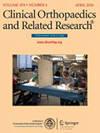Evaluation of Clinical Tests to Diagnose Iliopsoas Tendinopathy.
IF 4.2
2区 医学
Q1 ORTHOPEDICS
引用次数: 0
Abstract
BACKGROUND Diagnosing iliopsoas tendinopathy is challenging because of nonspecific pain patterns and clinical signs overlapping with those of other hip conditions. Although peritendinous anesthetic injections provide the best diagnostic accuracy, they are invasive and resource intensive. Conventional clinical tests largely focus on hip flexion, potentially overlooking the diagnostic contribution of the muscle's secondary function-external rotation. A newly described hip-external rotation-flexion-ceiling (HEC) test combines the primary function (hip flexion) with the secondary function (external rotation) of the iliopsoas, potentially offering enhanced diagnostic reliability. QUESTIONS/PURPOSES This study aimed to (1) determine the diagnostic accuracy of the HEC test and 10 conventional physical examination tests for iliopsoas-related groin pain; (2) detect "good" and "poor" tests for diagnosing iliopsoas tendinopathy based on three diagnostic performance criteria before and after anesthetic injection (mean pain reduction, optimal cutoff value for pain reduction, and area under the curve [AUC]); and (3) rank all tests, based on the same criteria, to identify the best diagnostic tool. METHODS In this retrospective study at a high-volume arthroplasty community hospital, we reviewed 48 consecutive fluoroscopy-guided iliopsoas tendon injections performed for persistent groin pain between October 2023 and May 2024. After excluding four patients without any data on the clinical tests performed, a population of 44 participants (mean age 48 ± 15 years; 34% male) remained, which included both native hips (52%) and patients who had undergone THA (48%). Eleven clinical tests-including the novel HEC test and 10 conventional tests (such as resisted hip flexion seated and straight leg raise [SLR] in neutral and external rotation)-were performed before and after a fluoroscopy-guided iliopsoas injection, with an improvement in their characteristic groin pain serving as the diagnostic gold standard. A test was considered "good" if it met all three criteria: (1) a significant mean VAS pain score reduction of ≥ 3 points after injection, (2) a significant optimal cutoff value for pain reduction of ≥ 4, and (3) a significant AUC of ≥ 0.80. A test meeting none of these three criteria was considered "poor." Using the same three criteria, each clinical test with at least 30 valid observations received a ranking position for each criterion, and these three ranks were summed to produce a total score. The test with the lowest total score was deemed the best, followed by the tests with higher scores. Statistical analysis involved estimating sensitivity, specificity, AUC, and optimal cutoff values using receiver operating characteristic curves and the Youden J statistic. RESULTS In 82% (36 of 44) of patients who experienced pain reduction after injection and who were diagnosed with iliopsoas tendinopathy, the following tests had the most clinically important pain reduction after infiltration: the HEC test (6.0 ± 2.1; p < 0.001), resisted hip flexion (seated) (5.1 ± 1.3; p < 0.001), and SLR in exorotation (4.9 ± 1.4; p < 0.001). The HEC test demonstrated a sensitivity of 94%, specificity of 88%, and an AUC of 0.99, with a high cutoff (VAS score reduction of 5) outperforming conventional tests. Three tests-including the HEC test, resisted hip flexion (seated), and resisted hip external rotation (seated)-met all three criteria to be classified as "good" tests, whereas the Thomas test, SLR in neutral, and the snapping hip test were deemed "poor" tests. The HEC test was ranked best to detect iliopsoas tendinopathy, followed by the resisted hip flexion (seated), SLR in exorotation, and resisted hip external rotation (seated). CONCLUSION The HEC test is an accurate diagnostic maneuver for iliopsoas tendinopathy offering improved sensitivity and specificity compared with conventional tests. Surgeons should consider incorporating the HEC test into routine evaluations of patients with groin pain to enhance diagnostic precision and optimize treatment strategies. Future studies should focus on interobserver reliability and assess the test's performance across diverse patient populations. LEVEL OF EVIDENCE Level III, diagnostic study.诊断髂腰肌肌腱病变的临床试验评价。
诊断髂腰肌肌腱病是具有挑战性的,因为非特异性的疼痛模式和临床症状与其他髋关节疾病重叠。虽然肛周麻醉注射提供了最好的诊断准确性,但它们是侵入性的和资源密集的。传统的临床测试主要集中在髋关节屈曲,潜在地忽略了肌肉的次要功能-外旋的诊断贡献。新近描述的髋关节-外旋-屈-顶(HEC)测试结合了髂腰肌的主要功能(髋关节屈曲)和次要功能(外旋),潜在地提供了更高的诊断可靠性。问题/目的本研究旨在(1)确定HEC检查和10项常规体格检查对髂腰肌相关腹股沟疼痛的诊断准确性;(2)根据麻醉注射前后的三个诊断表现标准(平均疼痛减轻、疼痛减轻的最佳截止值和曲线下面积[AUC]),检测诊断髂腰肌肌腱病变的“好”和“差”指标;(3)根据相同的标准对所有测试进行排序,以确定最佳诊断工具。方法:在一所大容量关节置换社区医院进行的回顾性研究中,我们回顾了2023年10月至2024年5月期间连续48例在透视引导下髂腰肌肌腱注射治疗持续性腹股沟疼痛的患者。在排除4名没有任何临床试验数据的患者后,44名参与者(平均年龄48±15岁;34%的男性)仍然存在,其中包括原生髋关节(52%)和接受THA(48%)的患者。在透视引导下髂腰肌注射前后进行了11项临床试验,包括新型HEC试验和10项常规试验(如坐位抗髋屈曲和中立和外旋直腿抬高[SLR]),并将其特征性腹股沟疼痛的改善作为诊断的金标准。如果满足所有三个标准,则认为测试“良好”:(1)注射后VAS平均疼痛评分显著降低≥3分,(2)疼痛减轻的显著最佳临界值≥4分,(3)显著AUC≥0.80。不满足这三个标准的测试被认为是“差的”。使用相同的三个标准,每个至少有30个有效观察的临床试验在每个标准中获得一个排名位置,并将这三个排名相加以产生总分。总分最低的测试被认为是最好的,其次是得分较高的测试。统计分析包括使用受试者工作特征曲线和Youden J统计量估计敏感性、特异性、AUC和最佳截止值。结果在44例确诊为髂腰肌肌腱病变的患者中,有82%(36 / 44)的患者在注射后疼痛减轻中,下列检查对浸润后疼痛减轻的临床意义最大:HEC检查(6.0±2.1;P < 0.001),抗髋屈曲(坐位)(5.1±1.3;p < 0.001),驱魔时单反(4.9±1.4;P < 0.001)。HEC检测的灵敏度为94%,特异性为88%,AUC为0.99,临界值高(VAS评分降低5分)优于传统检测。三项测试——包括HEC测试、抗髋关节屈曲(坐位)和抗髋关节外旋(坐位)——满足所有三个标准,被归类为“良好”测试,而Thomas测试、中立SLR和髋裂测试被认为是“差”测试。HEC测试被认为是检测髂腰肌肌腱病变的最佳方法,其次是抗髋屈曲(坐位)、外旋SLR和抗髋外旋(坐位)。结论HEC试验是一种诊断髂腰肌肌腱病变的准确方法,与常规检查相比,具有更高的敏感性和特异性。外科医生应考虑将HEC检查纳入腹股沟疼痛患者的常规评估,以提高诊断准确性和优化治疗策略。未来的研究应关注观察者之间的可靠性,并评估该测试在不同患者群体中的表现。证据等级:诊断性研究III级。
本文章由计算机程序翻译,如有差异,请以英文原文为准。
求助全文
约1分钟内获得全文
求助全文
来源期刊
CiteScore
7.00
自引率
11.90%
发文量
722
审稿时长
2.5 months
期刊介绍:
Clinical Orthopaedics and Related Research® is a leading peer-reviewed journal devoted to the dissemination of new and important orthopaedic knowledge.
CORR® brings readers the latest clinical and basic research, along with columns, commentaries, and interviews with authors.

 求助内容:
求助内容: 应助结果提醒方式:
应助结果提醒方式:


